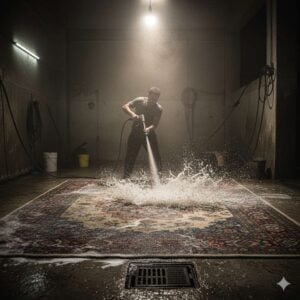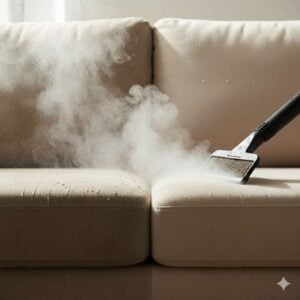Mould remediation is an essential process for maintaining a healthy home environment. Often overlooked, mould can pose significant health risks and structural damage if left unaddressed. In our guide, “10 Pro Tips for Thorough Mould Remediation in Your Living Space,” we delve into practical and effective strategies to tackle mould issues. Understanding the importance of identifying, treating, and preventing mould is key to safeguarding your home’s integrity and your family’s well-being. Join us as we explore these vital tips to equip you with the knowledge needed for successful mould remediation, ensuring your living space remains safe and mould-free.
[lwptoc]
Table of Contents
Toggle1. Identifying Mould Growth
Effective mould remediation begins with accurately identifying mould growth in your living space. Mould often manifests as discolored spots or patches on various surfaces like walls, ceilings, and floors, appearing in hues of black, green, white, or grey. These spots may exhibit a fuzzy or slimy texture, a clear sign of active mould growth. Another significant indicator is the presence of musty odors, which suggest hidden mould in areas less visible, such as behind wallpapers or underneath carpets.
Regular inspections are crucial, especially in damp-prone areas like bathrooms, kitchens, and basements. Pay attention to corners, crevices, and any areas that have experienced water damage or leakage. Early detection is crucial; the sooner mould is identified, the easier it is to manage and eradicate.
Being vigilant about mould growth is essential for maintaining a healthy living environment. If you detect persistent musty odors or see visible signs of mould, it’s time to investigate further or seek professional advice.
2. Assessing the Extent of Mould
After identifying mould in your space, thoroughly assessing its extent is essential. Smaller, localized mould growth can often be handled through DIY methods. However, widespread or hidden mould infestations generally demand professional intervention. Signs that indicate a more severe mould issue include peeling paint, warped materials, or a persistent musty smell, suggesting that mould is more extensive than what’s visible on the surface.
If the mould covers a large area, particularly in HVAC systems or within walls, professional remediation becomes necessary for effective and safe removal. It’s crucial to understand that mould can penetrate deep into surfaces, making superficial cleaning inadequate. Overlooking the extent of mould damage can lead to incomplete remediation, causing the problem to recur and potentially worsening over time.
Determining the full scope of mould damage often requires expertise beyond the average homeowner’s knowledge. In such cases, consulting with mould remediation specialists is advisable. They can accurately assess the situation and recommend the most effective remediation strategies. For more insights into professional mould assessment, 3 Unbeatable Mold Remediation Services for Peace of Mind offers a detailed overview.
3. Choosing the Right Remediation Strategy
Selecting the right mould remediation strategy is crucial and hinges on several factors, including the mould’s location, extent, and type. For minor, surface-level mould issues, DIY methods using household cleaning agents can be effective. However, more extensive or deeply ingrained mould infestations often require professional remediation techniques. These might include advanced methods like HEPA vacuuming or the application of specific biocides and antimicrobials.
When choosing a remediation method, it’s important to consider the safety and potential effectiveness of each approach. While some mild cases of mould can be addressed with over-the-counter cleaning products, professional-grade solutions and techniques are necessary for more severe cases. Each mould situation is unique, necessitating a tailored approach to ensure complete eradication.
Understanding the nuances of different mould remediation strategies is key to tackling the issue effectively.
4. Safety Precautions during Remediation
Safety is a top priority during the mould remediation process. Before beginning any mould removal work, it’s crucial to equip yourself with the appropriate protective gear. This includes wearing gloves, goggles, and a N95 respirator mask to prevent inhaling harmful mould spores. It’s also vital to ensure the area is well-ventilated to minimize exposure to mould and cleaning agents.
If you’re using chemical cleaners, follow the instructions carefully. Mixing different cleaning products can lead to the production of dangerous fumes, so it’s important to use each product as directed and in a well-ventilated space. Additionally, sealing off the affected area during the remediation process helps prevent mould spores from spreading to other parts of your home.
Prioritizing safety not only protects your health but also ensures a more effective and efficient mould remediation process. Simple precautions like wearing protective clothing and ensuring good ventilation can significantly reduce the risk of health issues and improve the overall success of the mould removal effort.
5. Proper Ventilation and Air Filtration
Proper ventilation and air filtration play critical roles in the mould remediation process, helping prevent the spread of mould spores throughout your home. During mould removal, it’s important to keep windows open or use fans to direct air outside, ensuring that spores are not circulated indoors. In situations where natural ventilation is inadequate, such as in basements or larger enclosed spaces, employing air purifiers equipped with HEPA filters can be highly effective. These filters are specifically designed to capture tiny mould spores, significantly reducing their presence in the air.
Mechanical ventilation systems can also be instrumental in managing air quality, particularly in larger homes or buildings where natural airflow is limited. Ensuring that these systems are well-maintained and functioning optimally is key to maintaining a mould-free environment post-remediation.
Effective air management is a vital component of successful mould remediation. It not only helps contain and reduce the spread of mould during the remediation process but also contributes to the overall air quality of your living space.
6. Effective Cleaning Solutions
Selecting effective cleaning solutions is a vital step in mould remediation. For non-porous surfaces, cleaners with bleach or hydrogen peroxide can be effective, killing mould and removing stains. It’s important to use these chemicals as directed, ensuring the area is well-ventilated to avoid inhaling fumes. For porous surfaces like wood or drywall, more specialized mould-cleaning products are recommended. These are designed to penetrate and clean without causing further damage.
Natural alternatives like vinegar or baking soda can be effective for smaller mould issues and are safer for those sensitive to harsher chemicals. Regardless of the cleaning solution, thorough application and proper drying are crucial to ensure all mould spores are eradicated. Remember, some mould infestations, especially those deep within surfaces, may require professional-grade cleaning solutions and techniques. Resources like Professional Mold Removal: 4 Secrets You Can’t Afford to Miss offer insights into effective cleaning methods for serious mould problems.
7. Addressing Moisture Sources
To prevent future mould growth, it’s essential to address the sources of moisture in your home. This includes repairing leaks in plumbing, roofing, or windows and ensuring proper insulation to prevent condensation. Utilizing dehumidifiers in damp areas like basements can help maintain optimal indoor humidity levels. Regularly check and clean gutters and downspouts to prevent water from accumulating around your home’s foundation.
Moisture control is an ongoing task requiring regular monitoring and maintenance. Keeping your home dry is crucial in preventing mould recurrence. For additional tips on managing indoor moisture and preventing mould, Mold Cleaning Services: 7 Elite Services to Restore Comfort provides practical advice and guidelines.
8. Regular Inspections Post-Remediation
After mould remediation, conducting regular inspections is vital to ensure the mould does not return. Check previously affected areas and other potential mould hotspots for any signs of recurrence. Be attentive to musty odors or any new moisture issues, as these can be early indicators of mould growth. Consistent inspections enable early intervention if mould is detected, preventing it from becoming a larger issue.
Scheduling annual professional inspections can be beneficial, especially for homes with a history of mould problems. Professionals can provide a more thorough examination and identify potential issues you might miss. For guidance on effective post-remediation inspections, Home Mold Removal: 5 Tips That Actually Work offers useful information.
9. Educating Occupants on Mould Prevention
Educating everyone in your household about mould prevention is crucial for maintaining a healthy living environment. Discuss the importance of spotting early signs of mould, maintaining low humidity levels, and ensuring proper ventilation. Regular habits like using exhaust fans and opening windows can significantly improve air circulation and reduce mould risk.
Providing comprehensive education on mould prevention is especially important in shared living spaces to ensure consistent preventative practices. For an extensive guide on mould prevention strategies, Mould and Mildew: Top 10 Solutions for Your Home is an excellent resource offering a wide range of tips and methods.
10. When to Seek Professional Help
Knowing when to seek professional help for mould remediation is key. If the mould covers a large area, is within HVAC systems, or you suspect hidden mould, it’s time to consult experts. Professionals have the necessary tools, expertise, and protective equipment to handle extensive mould issues safely and effectively. They can also identify and tackle the root causes of mould, helping prevent future occurrences.
Why Bio-on for Mould Remediation?
When it comes to mould remediation in your living space, choosing the right professionals is crucial for effective and safe resolution. Bio-On stands out as a top choice for several reasons:
Expertise and Experience: Bio-On’s team of professionals is highly skilled and experienced in mould remediation. They possess extensive knowledge about different types of mould and the best methods for their removal. This expertise ensures that the mould is not just superficially cleaned but completely eradicated.
Advanced Techniques and Equipment: Bio-On utilizes the latest technologies and equipment in mould remediation. Their advanced methods, like HEPA vacuuming and the use of eco-friendly biocides, ensure thorough cleaning and prevention of mould recurrence. This approach is crucial for dealing with mould in hard-to-reach areas and for ensuring long-term results.
Customized Solutions: Understanding that each mould situation is unique, Bio-On offers customized remediation plans tailored to the specific needs of your space. They assess the extent of mould growth and the specific conditions of your home to provide the most effective solution.
Health and Safety Focus: Bio-On prioritizes the health and safety of their clients. During the remediation process, they take necessary precautions to protect the occupants from exposure to harmful spores. Their use of safe, non-toxic products is particularly important for homes with children, pets, or individuals with allergies.
Comprehensive Approach: Bio-On’s approach to mould remediation is comprehensive. They not only focus on removing existing mould but also on identifying and fixing the underlying causes of moisture, which is crucial in preventing future mould issues.
Customer Satisfaction: Commitment to customer satisfaction is a cornerstone of Bio-On’s service. They ensure clear communication, reliability, and transparency throughout the remediation process, building trust and ensuring peace of mind for their clients.
Choosing Bio-On for mould remediation means opting for a service that combines expertise, advanced techniques, customized care, and a strong focus on health and safety. This comprehensive approach ensures that your mould problem is effectively resolved, contributing to a healthier and safer living environment.
Conclusion
In conclusion, effectively tackling mould in your living space is crucial for maintaining a healthy and safe environment. Recognizing the signs of mould growth, understanding its extent, and choosing the right remediation strategy are key steps in this process. Employing safety precautions, ensuring proper ventilation, and addressing moisture sources are essential for successful remediation and preventing future growth. Education on mould prevention and knowing when to seek professional help are also vital. By following these comprehensive steps and seeking expert assistance when necessary, you can ensure your home remains a clean, healthy, and mould-free space for you and your family.













